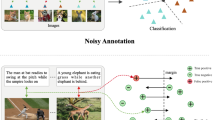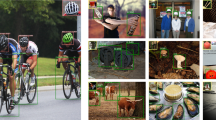Abstract
Recently, the triplet loss is commonly used in many deep person re-identification (ReID) frameworks to learn an embedding space in which similar data points are close and dissimilar data points are far away. However, the triplet loss simply focuses on the relative orders of points. This may lead to a relatively large intra-class variance and then a weak generalization capacity on the test set. In this paper, we propose a mini-cluster loss, which regards images belonging to the same identity as a mini-cluster and treats them as a whole during the training instead of considering them separately. For each mini-cluster in a batch, we define the largest distance between points in a mini-cluster as its inner divergence and the shortest distance with outer points as its outer divergence. By constraining the outer divergence larger than the inner divergence, our framework with the mini-cluster loss achieves the more compact mini-clusters while keeping the diversity distributions of the classes. As a result, a better generalization ability and a higher performance can be obtained. In the extensive experiments, our proposed framework achieves a state-of-the-art performance on two large-scale person ReID datasets (Market1501, DukeMTMC-reID) which clearly demonstrates its effectiveness. Specifically, 72.44% mAP and 87.05% rank-1 score are achieved on the Market1501 dataset with single query setting, 78.17% mAP and 91.05% rank-1 score with multiply query setting, and on the DukeMTMC-reID dataset, 60.19% mAP and 77.20% rank-1 score are obtained.







Similar content being viewed by others
References
Bai S, Bai X, Qi T (2017) Scalable person re-identification on supervised smoothed manifold. In: CVPR, pp 2530–2539
Barbosa IB, Cristani M, Caputo B, Rognhaugen A, Theoharis T (2017) Looking beyond appearances: synthetic training data for deep cnns in re-identification. Comput Vis Image Underst, 1–14
Chen Y, Chen Y, Wang X, Tang X (2014) Deep learning face representation by joint identification-verification. In: NIPS, pp 1988–1996
Chen W, Chen X, Zhang J, Huang K (2017) Beyond triplet loss: a deep quadruplet network for person re-identification. In: CVPR, pp 403–412
De C, Gong Y, Zhou S, Wang J, Zheng N (2016) Person re-identification by multi-channel parts-based cnn with improved triplet loss function. In: CVPR, pp 1335–1344
Ding S, Lin L, Wang G, Chao H (2015) Deep feature learning with relative distance comparison for person re-identification. Pattern Recogn 48(10):2993–3003
Gong S, Cristani M, Yan S, Chen CL (2014) Person re-identification. Springer
He K, Zhang X, Ren S, Sun J (2016) Deep residual learning for image recognition. In: CVPR, pp 770–778
Hermans A, Beyer L, Leibe B (2017) In defense of the triplet loss for person re-identification. arXiv:1703.07737, 1–10
Huang Y, Xu J, Wu Q, Zheng Z, Zhang Z, Zhang J (2018) Multi-pseudo regularized label for generated samples in person re-identification. arXiv:1801.06742, 1–12
Li W, Wang X (2013) Locally aligned feature transforms across views. In: CVPR, pp 3594–3601
Li W, Zhao R, Wang X (2012) Human reidentification with transferred metric learning. In: ACCV, pp 31–44
Li Z, Chang S, Liang F, Huang TS, Cao L, Smith JR (2013) Learning locally-adaptive decision functions for person verification. In: CVPR, pp 3610–3617
Li D, Chen X, Zhang Z, Huang K (2017) Learning deep context-aware features over body and latent parts for person re-identification. In: CVPR, pp 384–393
Li W, Zhu X, Gong S (2017) Person re-identification by deep joint learning of multi-loss classification. IJCAI, 2194–2200
Liao S, Li SZ (2015) Efficient psd constrained asymmetric metric learning for person re-identification. In: ICCV, pp 3685–3693
Liu J, Zha ZJ, Qi T, Liu D, Yao T, Ling Q, Mei T (2016) Multi-scale triplet cnn for person re-identification. In: ACM on multimedia conference, pp 192–196
Matsukawa T, Okabe T, Suzuki E, Sato Y (2016) Hierarchical gaussian descriptor for person re-identification. In: CVPR, pp 1363–1372
Song HO, Yu X, Jegelka S, Savarese S (2016) Deep metric learning via lifted structured feature embedding. In: CVPR, pp 4004–4012
Schroff F, Kalenichenko D, Philbin J (2015) Facenet: a unified embedding for face recognition and clustering. In: CVPR, pp 815–823
Shen Y, Lin W, Yan J, Xu M, Wu J, Wang J (2015) Person re-identification with correspondence structure learning. In: ICCV, pp 3200–3208
Shi H, Yang Y, Zhu X, Liao S, Lei Z, Zheng W, Li SZ (2016) Embedding deep metric for person re-identification: a study against large variations. In: ECCV, pp 732–748
Sohn K (2016) Improved deep metric learning with multi-class n-pair loss objective. In: NIPS, pp 1857–1865
Su C, Yang F, Zhang S, Qi T, Davis LS, Gao W (2015) Multi-task learning with low rank attribute embedding for person re-identification. In: CVPR, pp 3739–3747
Sun Y, Zheng L, Deng W, Wang S (2017) Svdnet for pedestrian retrieval. ICCV, 3800–3808
Van Der Maaten L (2014) Accelerating t-sne using tree-based algorithms, vol 15
Vezzani R, Baltieri D, Cucchiara R (2013) People reidentification in surveillance and forensics:a survey. Acm Comput Surv 46(2):1–37
Voulodimos A, Doulamis N, Doulamis A, Protopapadakis E (2018) Deep learning for computer vision: a brief review. In: Comput Intell Neurosci, pp 1–13
Wang F, Zuo W, Lin L, Zhang D, Zhang L (2016) Joint learning of single-image and cross-image representations for person re-identification. In: CVPR, pp 1288–1296
Wang J, Zhou F, Wen S, Liu X, Lin Y (2017) Deep metric learning with angular loss. In: ICCV, pp 2593–2601
Wen Y, Zhang K, Li Z, Yu Q (2016) A discriminative feature learning approach for deep face recognition. In: ECCV, pp 499–515
Wu S, Chen YC, Li X, Wu AC, You JJ, Zheng WS (2016) An enhanced deep feature representation for person re-identification. In: WACV, pp 1–8
Wu C-Y, Manmatha R, Smola AJ, Krahenbuhl P (2017) Sampling matters in deep embedding learning. In: CVPR, pp 2840–2848
Xiao T, Li H, Ouyang W, Wang X (2016) Learning deep feature representations with domain guided dropout for person re-identification. In: CVPR, pp 1249–1258
Xiao T, Li S, Wang B, Lin L, Wang X (2017) Joint detection and identification feature learning for person search. In: CVPR, pp 3376–3385
Xu J, Zhao R, Zhu F, Wang H, Ouyang W (2018) Attention-aware compositional network for person re-identification. CVPR, 2119–2128
Yang Y, Lei Z, Zhang S, Shi H, Li SZ (2016) Metric embedded discriminative vocabulary learning for high-level person representation. In: AAAI, pp 3648–3654
Yang Y, Wen L, Lyu S, Li SZ (2017) Unsupervised learning of multi-level descriptors for person re-identification. In: AAAI, vol 1, pp 4306–4312
Yi D, Lei Z, Li SZ (2014) Deep metric learning for practical person re-identification. Comput Sci, 34–39
Zhang L, Xiang T, Gong S (2016) Learning a discriminative null space for person re-identification. In: CVPR, pp 1239–1248
Zhang X, Fang Z, Wen Y, Li Z, Yu Q (2017) Range loss for deep face recognition with long-tail. ICCV, 1–10
Zhao R, Ouyang W, Wang X (2014) Learning mid-level filters for person re-identification. In: CVPR, pp 144–151
Zheng WS, Gong S, Xiang T (2011) Person re-identification by probabilistic relative distance comparison. In: CVPR, pp 649–656
Zheng W, Gong S, Xiang T (2013) Reidentification by relative distance comparison. IEEE Trans Pattern Anal Mach Intell 35(3):653–668
Zheng L, Shen L, Lu T, Wang S, Wang J, Qi T (2015) Scalable person re-identification: a benchmark. In: ICCV, pp 1116–1124
Zheng Z, Zheng L, Yang Y (2017) A discriminatively learned cnn embedding for person re-identification. arXiv:1611.05666, 1–10
Zheng Z, Zheng L, Yi Y (2017) Unlabeled samples generated by gan improve the person re-identification baseline in vitro. ICCV, 3754–3762
Zhou S, Wang J, Wang J, Gong Y, Zheng N (2017) Point to set similarity based deep feature learning for person reidentification. In: CVPR, pp 3741–3750
Acknowledgment
This work was supported by the National Natural Science Foundation of China (61572214, 61602244, U1536203 and U1504611), and partially sponsored by CCF-Tencent Open Research Fund.
Author information
Authors and Affiliations
Corresponding authors
Additional information
Publisher’s note
Springer Nature remains neutral with regard to jurisdictional claims in published maps and institutional affiliations.
Rights and permissions
About this article
Cite this article
Yuan, C., Guo, J., Feng, P. et al. Learning deep embedding with mini-cluster loss for person re-identification. Multimed Tools Appl 78, 21145–21166 (2019). https://doi.org/10.1007/s11042-019-7446-2
Received:
Revised:
Accepted:
Published:
Issue Date:
DOI: https://doi.org/10.1007/s11042-019-7446-2




